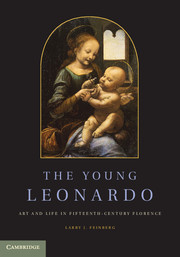Book contents
- Frontmatter
- Contents
- Figures
- Acknowledgments
- Introduction
- 1. Childhood
- 2. Florence and Cosimo the Elder
- 3. The Cultural Climate of Florence
- 4. First Years in Florence and the Verrocchio Workshop
- 5. First Works in Florence and the Artistic Milieu
- 6. Early Pursuits in Engineering ??? Hydraulics and the Movement of Water
- 7. The Bust of a Warrior and Leonardo's Creative Method
- 8. Early Participation in the Medici Court
- 9. Leonardo's Personality and Place in Florentine Society
- 10. Important Productions and Collaborations in the Verrocchio Shop
- 11. Leonardo's Colleagues in the Workshop
- 12. Leonardo's Madonna of the Carnation and the Exploration of Optics
- 13. The Benois Madonna and Continued Meditations on the Theme of Sight
- 14. The Madonna of the Cat
- 15. Leonardo, the Medici, and Public Executions
- 16. Leonardo and Ginevra de??? Benci
- 17. Leonardo as Portraitist and Master of the Visual Pun
- 18. The Young Sculptor
- 19. The Madonna Litta
- 20. The Adoration of the Magi and Invention of the High Renaissance Style
- 21. The Adoration and Leonardo's Military Interests
- 22. Leonardo and Allegorical Conceits for the Medici Court
- 23. Early Ideas for the Last Supper
- 24. Leonardo and the Saint Sebastian
- 25. Saint Jerome
- 26. First Thoughts for the Virgin of the Rocks and the Invention of the Mary Magdalene-Courtesan Genre
- 27. Milan
- 28. Leonardo and the Sforza Court
- Bibliography with Endnotes
- Index
5. - First Works in Florence and the Artistic Milieu
Published online by Cambridge University Press: 07 September 2011
- Frontmatter
- Contents
- Figures
- Acknowledgments
- Introduction
- 1. Childhood
- 2. Florence and Cosimo the Elder
- 3. The Cultural Climate of Florence
- 4. First Years in Florence and the Verrocchio Workshop
- 5. First Works in Florence and the Artistic Milieu
- 6. Early Pursuits in Engineering ??? Hydraulics and the Movement of Water
- 7. The Bust of a Warrior and Leonardo's Creative Method
- 8. Early Participation in the Medici Court
- 9. Leonardo's Personality and Place in Florentine Society
- 10. Important Productions and Collaborations in the Verrocchio Shop
- 11. Leonardo's Colleagues in the Workshop
- 12. Leonardo's Madonna of the Carnation and the Exploration of Optics
- 13. The Benois Madonna and Continued Meditations on the Theme of Sight
- 14. The Madonna of the Cat
- 15. Leonardo, the Medici, and Public Executions
- 16. Leonardo and Ginevra de??? Benci
- 17. Leonardo as Portraitist and Master of the Visual Pun
- 18. The Young Sculptor
- 19. The Madonna Litta
- 20. The Adoration of the Magi and Invention of the High Renaissance Style
- 21. The Adoration and Leonardo's Military Interests
- 22. Leonardo and Allegorical Conceits for the Medici Court
- 23. Early Ideas for the Last Supper
- 24. Leonardo and the Saint Sebastian
- 25. Saint Jerome
- 26. First Thoughts for the Virgin of the Rocks and the Invention of the Mary Magdalene-Courtesan Genre
- 27. Milan
- 28. Leonardo and the Sforza Court
- Bibliography with Endnotes
- Index
Summary
The earliest surviving traces of Leonardo's hand – and affection for animals – would seem to be found in the Tobias and the Angel (c. 1472–73), now in the National Gallery, London (fig. 5), a collaborative picture from the Verrocchio shop. The participation of two hands in the work's execution has long been apparent, in light of the stylistic contrast between the sculptural rigidity of the anatomy and costumes of the figures and the more freely rendered dog and fish. The wavelike patterns of the dog's unruly fur compare closely to the many sketches of the movement of water and hair that soon after streamed from Leonardo's pen. The dead-eyed helplessness and glistening scales of the carp (or tinca), gasping for breath, suggest the touch of someone who studied aquatic life closely. Famously able to survive for long periods out of water, the common river fish would have provided a live (and fresh-smelling) model for hours before becoming a meal.
An appreciative Verrocchio may have permitted Leonardo's brush to delineate as well the lively, luminescent curls of Tobias's hair and the intricate, knotted and fluttering belts and hems of the figures’ garments. Leonardo no doubt distinguished himself in the studio in such subtle application of highlights and in the other remarkable effects of illumination he could attain in the mixed media of tempera and oil paint, then relatively new to Florence. Consequently, he became the person called on to add those last, gilt-edged details, the final polish, before the works left the shop.
- Type
- Chapter
- Information
- The Young LeonardoArt and Life in Fifteenth-Century Florence, pp. 33 - 38Publisher: Cambridge University PressPrint publication year: 2011

